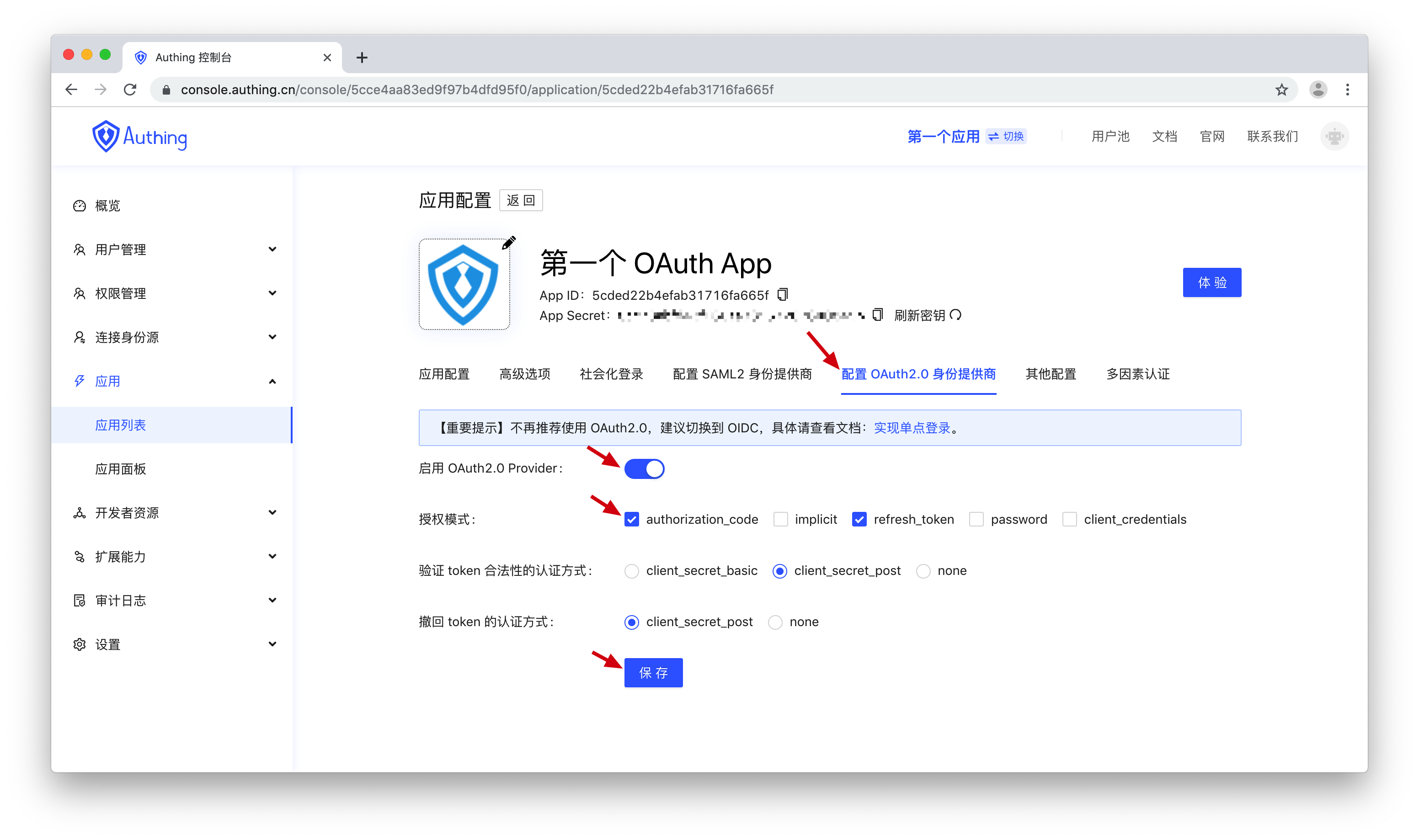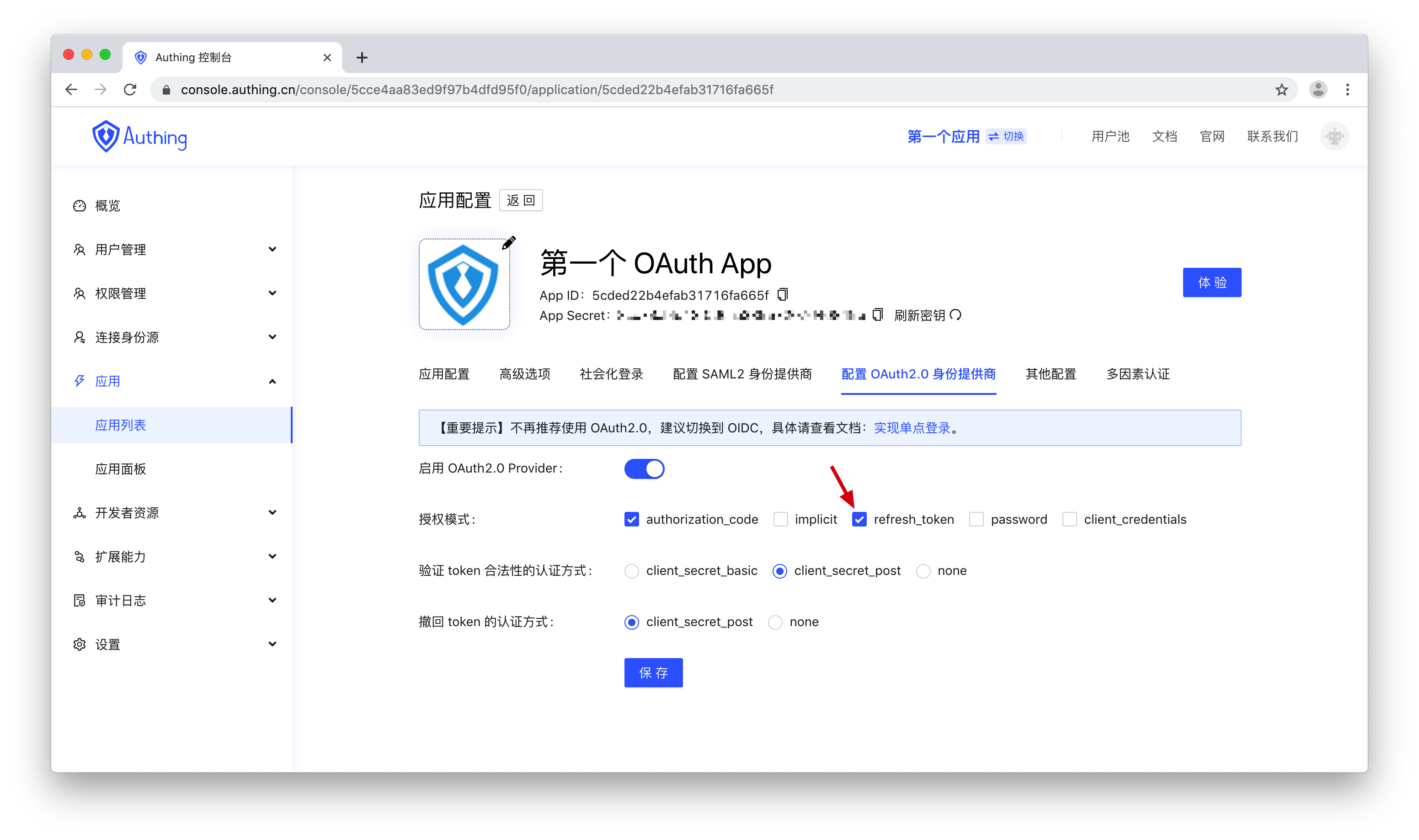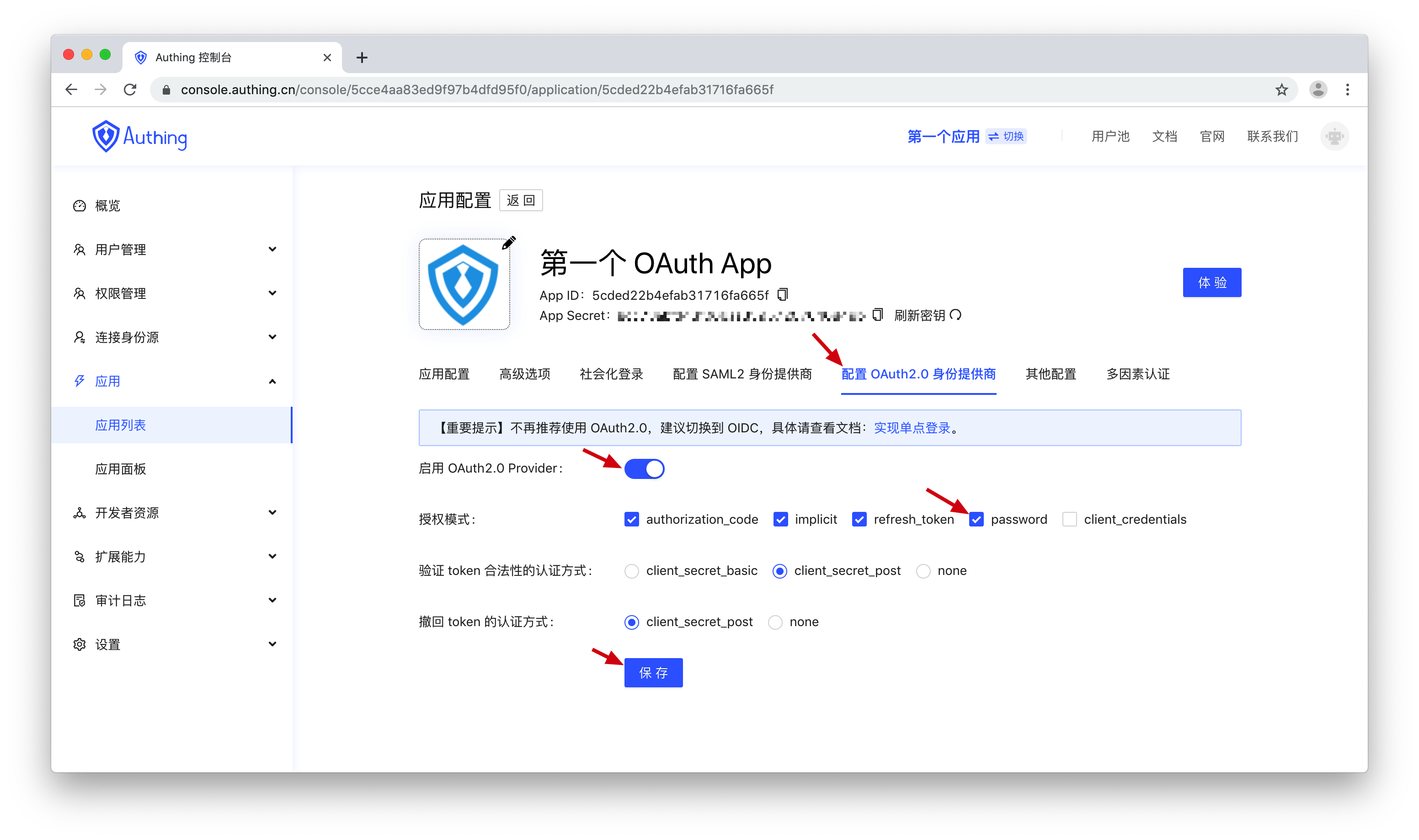# 使用 OAuth 授权
Node.JS Demo 源码:https://github.com/Authing/oauth-demo
# 使用授权码(Authorization Code Flow)模式
以下时序图展示了一种 OAuth2.0 授权码模式的处理方式。

# 01 - 在控制台配置 OAuth2.0 Provider
如果你还没有创建应用,请先在控制台 > 应用 > 应用列表,点击右上角的按钮「创建应用」。
进入控制台 > 应用 > 应用列表,找到你的应用,点击「配置」。

在「配置OAuth2.0 身份提供商」选项卡,打开「启用 OAuth2.0 Provider
」开关,然后在下方的授权模式中,打开 authorization_code 模式,然后点击「保存」。

# 02 - 发起登录请求
拼接一个链接并让终端用户在浏览器中访问,发起 OAuth2.0 授权登录请求。
发起授权需要拼接一个用来授权的 URL,并让终端用户在浏览器中访问,具体参数如下:
请求示例:
https://<你的应用域名>.authing.cn/oauth/auth?client_id=5c9b079883e333d55a101082&redirect_uri=https://www.example.cn/example&scope=user&response_type=code&state=52378542395
# 03 - 用户登录
发起 OAuth2.0 登录之后,如果用户先前未在 OP 登录过,OP 会将用户重定向到登录页面,引导用户完成在 OP 的认证,此时用户需要选择一种方式进行登录:
你可以前往这个网址体验:https://first-oauth-app.authing.cn/login (opens new window)

用户登录
Authing 将验证此用户是否合法,验证通过后会将浏览器重定向到发起授权登录请求时指定的 redirect_uri 并通过 URL query 传递授权码 code 参数。
# 04 - 使用 code 换取 token
换取 token 时需要将 OAuth2.0 Provider 的凭证信息发送给 Authing。OAuth2.0 Provider 支持两种换取 token 时的认证方式。
client_secret_post 方式换取 token
将应用 ID 和应用密钥通过 POST Body 发送到 OAuth2.0 token 端点。
NodeJS code 换取 token 请求示例代码:
let code2tokenResponse;
try {
code2tokenResponse = await axios.post(
"https://<你的应用域名>.authing.cn/oauth/token",
qs.stringify({
code,
client_id: appId,
client_secret: appSecret,
grant_type: "authorization_code",
redirect_uri,
}),
{
headers: {
"Content-Type": "application/x-www-form-urlencoded",
},
}
);
} catch (error) {
ctx.body = error.response.data;
return;
}
使用 curl 发送请求示例:
curl --location --request POST 'https://<你的应用域名>.authing.cn/oauth/token' \
--header 'Content-Type: application/x-www-form-urlencoded' \
--data-urlencode 'code=61yhuOVrgyhKlFTU~bnEKA_fnnz' \
--data-urlencode 'client_id=5e37979f7b757ead14c534af' \
--data-urlencode 'client_secret=64b517f8de3648091654eb4ee9b479d3' \
--data-urlencode 'grant_type=authorization_code' \
--data-urlencode 'redirect_uri=https://baidu.com'
返回示例:
{
"access_token": "de60825d1bffd91474e9ac6a08a84bdc71f7f404",
"token_type": "Bearer",
"expires_in": 3599,
"refresh_token": "c0b0b4acd686d30bb8b26dae73c2e64c1cec6698",
"scope": "user"
}
client_secret_basic 方式换取 token
client_secret_basic 是使用 HTTP Basic authentication 模式进行认证。
其中 Authorization 请求头 Basic<空格> 后的值为 <client_id>:<client_secret> 的 base64 值。
# 05 - 刷新 token
使用 refresh_token 刷新用户的 access_token。
如需使用刷新 token 功能,需要进入控制台 > 应用 > 应用列表,找到你的应用,点击「配置」,在「配置 OAuth2.0 身份提供商」选项卡,授权模式中勾选 refresh_ token。

refresh_token
# 06 - 撤回 token
撤回 token
可以撤回 access_token 和 refresh_token。
# 07 - 检验 token 状态
检验 token 状态
可以检测 access_token 的状态。
# 使用隐式模式(Implicit Flow)
OAuth2.0 隐式模式不会返回授权码 code,而是直接将 access_token 通过 URL hash 发送到回调地址前端,后端无法获取到这里返回的值,因为 URL hash 不会被直接发送到后端。
# 在控制台配置 OAuth 应用
进入控制台 > 应用 > 应用列表,找到你的应用,点击「配置」,在「配置 OAuth2.0 身份提供商」选项卡,找到授权模式,勾选 implicit 模式,最后点击「保存」。

# 发起授权
发起隐式模式的授权登录需要拼接一个 URL,并让终端用户在浏览器中访问,不能直接输入认证地址域名。具体参数如下:
| 参数名 | 意义 |
|---|---|
| client_id | 应用 ID。 |
| redirect_uri | 回调链接,用户在 OP 认证成功后,OP 会将 access_token 以 URL hash 的形式发送到这个地址。这个值必须出现在控制台配置的回调地址中,否则 OP 不允许向该地址回调。 |
| scope | 需要请求的权限,暂未实现,请填写 user。 |
| response_type | token |
| state | 一个随机字符串,用于防范 CSRF 攻击,如果 response 中的 state 值和发送请求之前设置的 state 值不同,说明受到攻击。 |
假设你创建了一个域名为 example 的 OAuth2.0 应用,那么发起隐式模式 OAuth2.0 授权登录的网址是:
GET https://example.authing.cn/oauth/auth?client_id=5ca765e393194d5891db1927&redirect_uri=https://example.com&scope=user&response_type=token&state=6223573295
# 获取 access_token
access_token 会以 URL hash 的形式传递,跳转后链接示例:
https://authing.cn/#access_token=56d7c5649b486abfa67798d11c7e98ea741cab58&state=1234124
换取用户信息的流程和授权码模式相同。
为什么信息在 URL hash 里而不是 query 里?因为 hash 内容不会直接发送到服务器,避免 access_token 被盗用。
# 使用 Password 模式
不推荐使用此模式,尽量使用其他模式。
# 在控制台配置 OAuth2.0 应用
进入 控制台 > 应用 > 应用列表,找到你的应用,在「配置 OAuth2.0 Provider」选项卡,授权模式中勾选 password。点击「保存」。

password
使用登录凭据换取 token
在 Password 模式中,可以直接使用用户的登录凭据(用户名 + 密码)换取 access_token
参考资料
# 使用 Client Credentials 模式
此模式用于获取关于 OAuth 应用本身的 access_token,持有该 access_token 可以用于获取该 OAuth 应用本身的信息。你不能通过这个 access_token 获取任何用户相关的信息。关于 Client Credentials 模式请参考 https://oauth.net/2/grant-types/client-credentials (opens new window)。
使用应用 ID 和应用密钥换取应用本身的 access_token
Client Credentials 模式中获取到的 access_token 的上下文是 OAuth 应用本身,持有此 token 可以证明你是该 OAuth Client 的所有者。
# 常见问题
# Token 有效时间
所有模式的
access_token有效时间都是 1 小时,refresh_token的有效时间为 2 周。
# 四种模式的区别
关于这四种模式的应用场景和区别,建议浏览 理解 OAuth2.0 (opens new window),一般情况下只需开启
authorization_code模式。